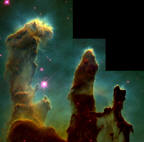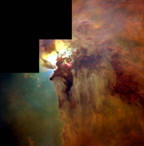|
> Emission Nebula
|
An emission nebula is a cloud of ionized gas (i.e. a plasma) emitting light of various colors. The most common source for ionization are high-energy photons emitted from a nearby hot star. Among the several different types of emission nebula are H II regions, in which star formation is taking place and young, massive stars are the source of the ionising photons; and planetary nebulae, in which a dying star has thrown off its outer layers, with the exposed hot core then ionizing them. Usually, a young star will ionize part of the same cloud from which it was born. Only big, hot stars can release the amount of energy required to ionize a significant part of a cloud. Often, an entire cluster of young stars is doing the work.
The nebula's color depends on its chemical composition and amount of
ionization. Due to the high prevalence of Hydrogen in interstellar gas,
and its relative low energy requirement for ionization, many emission
nebulae are red. If more energy is available, other elements can be
ionized and green and blue nebulae are possible. By examining the spectra
of nebulae, astronomers deduce their chemical content. Most emission
nebulae are about 90% hydrogen, with the remainder helium, oxygen,
nitrogen, and other elements.
Emission nebulae often have dark spots in them which result from clouds
of dust which block the light. The combination of emission nebula and dust
cloud make for some interesting looking objects, and many of these nebulae
bear the name of objects that they resemble, such as the North America
Nebula or the Cone Nebula.
|

